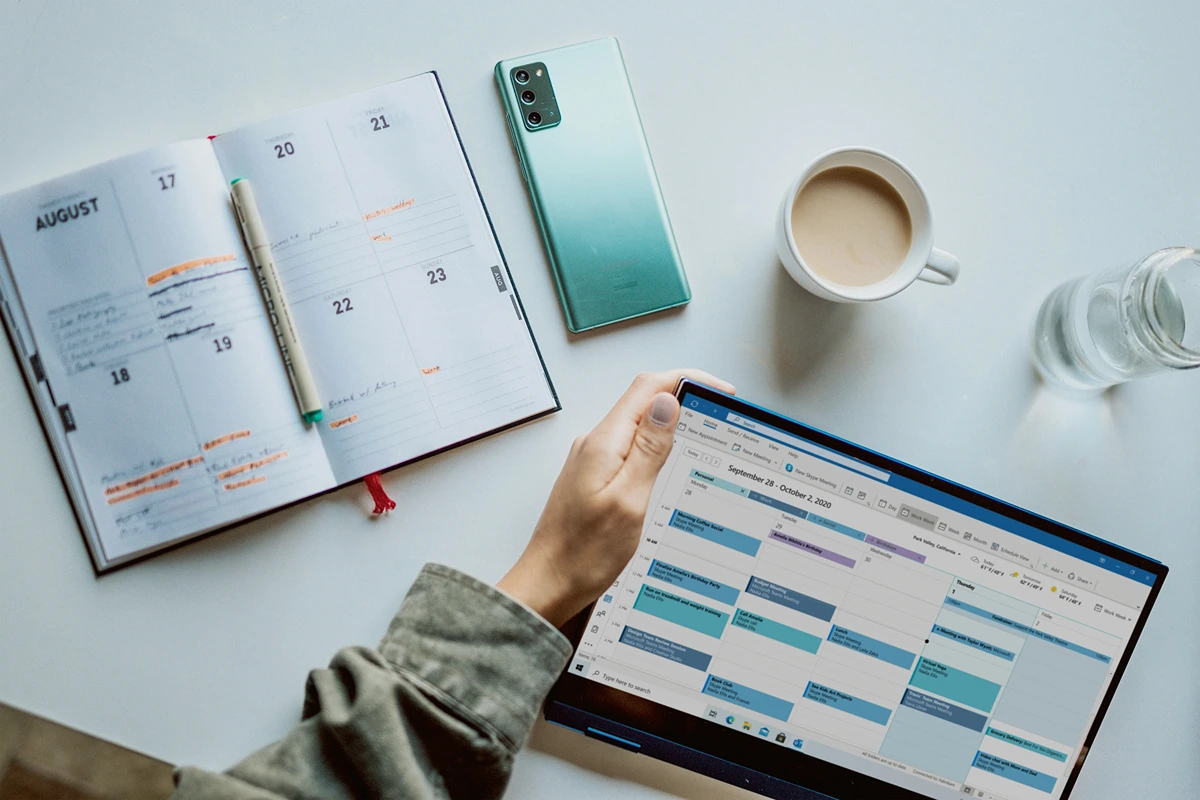Why deep work matters
Slack pings, calendar pop-ups, Reels on your phone—today’s “always-on” culture chips away at the long, quiet stretches your brain needs for complex thinking. Each switch of attention carries a hidden tax in lost momentum and mental fatigue (Mark, 2023). By contrast; deep work strategies, distraction-free effort on cognitively demanding tasks—offer a competitive edge (Newport, 2019).
Quick payoff: Deep-work sessions have been linked to higher productivity, faster learning, and greater job satisfaction (Newport, 2019; Tarafdar et al., 2015).
The neuroscience of distraction
Our brains are wired to notice novelty. Every notification delivers a micro-hit of dopamine that feels rewarding but fractures focus (Mark, 2023). Frequent task switching also raises cortisol, the stress hormone, which can increase anxiety and impair memory formation (Becker & Lanzl, 2023). Over time, this cycle weakens both well-being and output.
7 evidence-based deep work strategies
1. Time-block your day
Reserve 60- to 90 minute “focus blocks” on your calendar—then guard them like client meetings. Research shows that scheduling commitment boosts follow through (Newport, 2019).
2. Create a distraction-free zone
During focus blocks; silence non-essential notifications and remove phones from your workspace. Even a brief glance can cost up to 20 minutes of full cognitive recovery (Mark, 2023).
3. Embrace monotasking benefits
Switching between tasks increases errors and slows completion (Duff et al., 2014). Tackle one high-value item at a time to amplify quality—a monotasking benefit.
4. Use attention restoration breaks
After each focus block, step outside, stretch, or meditate for five minutes. Natural environments refresh depleted attention resources (Kaplan & Kaplan, 1989).
5. Apply digital minimalism
Keep only the apps and feeds that serve clear professional or personal value, pruning the rest (Newport, 2019). Fewer temptations = fewer self-interruptions. This leads to monotasking benefits.
6. Run weekly “deep work rituals”
- Sunday reset: Identify two important tasks.
- Morning prep: Review goals, clear workspace, set a timer.
- End-of-day audit: Log wins; adjust tomorrow’s planned deep work strategies.
Rituals signal the brain that it’s time to dive deep, shrinking ramp-up time (Newport, 2019).
7. Experiment with micro-detox sprints
Try a 24-hour social media fast or a device-free evening for attention restoration. Two week detox trials cut perceived stress and improved focus among heavy users (Coyne & Woodruff, 2023; Syvertsen & Enli, 2019).
Bridging digital balance and professional success
Cultivating deep-work habits isn’t anti-tech—it’s intentional tech. If you can control your attention instead of outsourcing it to algorithms; you deliver higher-quality work in less time. This can free up mental bandwidth for creativity and strategic thinking. Employers are beginning to recognize this link; teams that support deep-work cultures report lower burnout and higher output (Becker & Lanzl, 2023).
Key takeaways
- Deep work is a rare, marketable skill that boosts productivity, creativity, and well-being.
- Distractions hijack dopamine and elevate stress; monotasking and notification control reclaim your focus.
- Attention-restoration breaks and micro-detox sprints refresh the brain, enabling longer stretches of flow.
- Embedding rituals and digital-minimalist principles turns deep work from a one-off sprint into a sustainable habit.
Next steps
- Schedule one 90 minute focus block for tomorrow.
- Silence or mute every non-essential app for monotasking benefits.
- Afterward, take a five-minute nature break. Note how you feel.
- Repeat three times this week—then review the gains in output and clarity.
References
- Becker, J., & Lanzl, J. (2023). Segmentation preference and technostress: Integrators’ vs. segmenters’ experience of technology-induced demands and related spill-over effects. Information & Management, 60(5), Article 103712.
- Coyne, P., & Woodruff, S. J. (2023). Taking a break: The effects of a two-week social media digital detox on problematic smartphone and social media use. Behavioral Sciences, 13(12), 1004.
- Duff, B. R. L., Yoon, G., Wang, Z., & Anghelcev, G. (2014). Doing it all: Predictors of media multitasking. Journal of Interactive Advertising, 14(1), 11-23.
- Kaplan, R., & Kaplan, S. (1989). The experience of nature: A psychological perspective. Cambridge University Press.
- Mark, G. (2023). Attention Span: A groundbreaking way to restore balance, happiness and productivity. Hanover Square Press.
- Newport, C. (2019). Digital minimalism: Choosing a focused life in a noisy world. Portfolio.
- Syvertsen, T., & Enli, G. (2019). Digital detox: Media resistance and the promise of authenticity. Media, Culture & Society, 41(5), 665-681.
- Tarafdar, M., Maier, C., Laumer, S., & Weitzel, T. (2015). Explaining the link between technostress and technology addiction: A study of distraction as coping. Information Systems Journal, 25(2), 103-132.
- Zahariades, D. (2018). Digital Detox: The ultimate guide to beating technology addiction. Art of Productivity.
*Disclaimer: Offline Now offers educational coaching tips, not medical or therapeutic advice; please consult a qualified health professional for personal or clinical concerns.*



